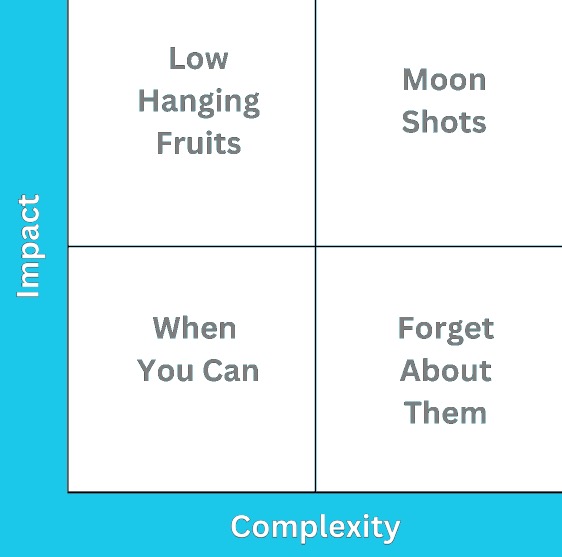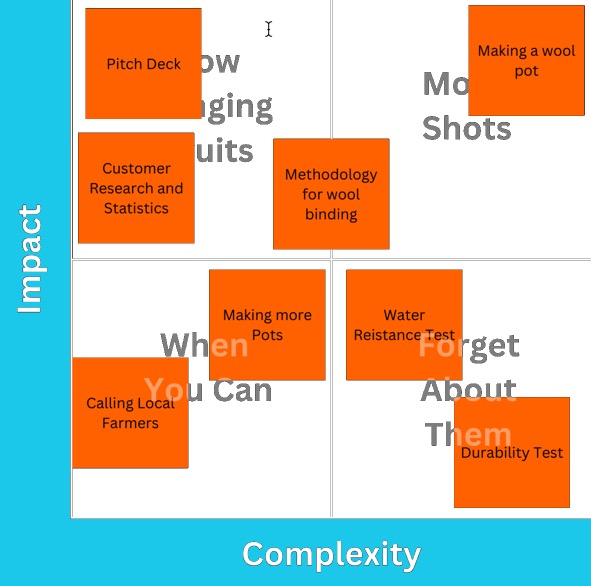One of the biggest mistakes project managers and founders make is chasing every feature customers suggest.
Customer understanding is key to good product design. We often rush out to gather feedback, returning with endless lists of “must-have” features. However, these features aren’t always what customers need — they’re just what they think they want.
Acting on every customer request puts your product on the fast track to Feature Purgatory, a state where endless features clog your roadmap, delay development, and bloat your product into an unpolished mess.
I learned this the hard way with my first startup. We spent a year chasing every feature idea, only to find ourselves with a bulky, unfocused product. By sheer luck, we pivoted into another market and survived.
This is where a prioritization framework like the Priority Matrix becomes essential. It ranks features using two axes: Complexity and Impact, helping you decide what deserves your team’s focus.
Overview of the Priority Matrix
The matrix works like this:
- Top-Left: High Impact, Low Complexity – Quick wins. Do these first.
- Top-Right: High Impact, High Complexity – Moonshots. Limit to a few key bets.
- Bottom-Left: Low Impact, Low Complexity – Nice-to-haves that you can develop during downtime.
- Bottom-Right: Low Impact, High Complexity – Forget them. They’re distractions.
Why the Priority Matrix Works
At a Techstars Startup Weekend, I joined a team pitching an idea to turn discarded wool into biodegradable seedling pots.
As brainstorming kicked off, ideas spiralled from crafting a simple prototype to building complex machinery and supply chains. Within hours, we were lost in “solutioneering,” forgetting the charm of our original pitch.
A mentor pulled us back:
“Journeys start with a vision. Explore too much, and you risk losing it.”
We wanted to reconnect with the original charm of our vision, and so we set ourselves a goal to build an MVP in the form of an actual product.
The features for this prototype became tasks we had to complete within 48 hours:
- Calling Local sheep farms to source discarded wool
- Creating a methodology to bind the wool together
- Making a Pot
- Testing their water resistance
- Making more Pots
- Creating the Pitch Deck
- Customer Research and statistics
- Testing their durability
This was a long list of tasks and with a pressing deadline we had to make the most of our time, so I decided to apply the Priority Matrix framework to our task list.
First, we collectively decided on what impact meant – we did this by establishing our projects Key Performance Indicators (KPIs). We had two:
- Allowing the judges to feel and experience our product
- Wool Pots had to be durable and not break
We ranked tasks by ‘impact’ on the vertical axis through team discussion, comparing each task’s contribution towards the agreed KPIs
For the “complexity” axis we had to make sure we used a rational metric to rank each task so as not to be biased towards certain tasks. I proposed an exponential scale, each factor (Skill, Research, Equipment, Facility) is assigned a weight based on its difficulty, with total complexity calculated as the sum of these weighted factors.
One-by-one we looked at each task and asked:
- Do we need to learn how to do this?
- Do we need to research a solution?
- Do we need equipment for this?
- Do we need a special place to work?
For example, when it came to making a pot, none of us knew how to work with wool. After some research, we discovered that we’d need cooking utensils, a hob, and a methodology to bind the wool together — clearly a task with very high complexity. Once we categorised all the tasks in our Priority Matrix, the picture became clearer.
The matrix showed that our focus had to be on the pitch deck and pot-making, while tasks like testing the pots could be deprioritised.
However, there was still a major challenge: making a pot remained an ultra-high complexity task.
That’s when we revisited the “Who we are?” section of the How to tell your product’s story framework.
Reflecting on our skills and resources, we discovered a hidden advantage: as president of an ECO gardening society, I had access to a barn equipped with a full kitchen and all the tools we needed. Suddenly, what seemed like an impossible moonshot became achievable.

When it came to presenting, we were the only team to show a completed, working physical product. We delivered a high impact idea with passion, even “testing” the pots durability by crushing them infront of the panel of judges.
We placed 2nd out of all the teams and won two hours of expert mentoring to continue our idea.
The bottom line
Whether you’re launching a startup or tackling a new project, the Priority Matrix can be your compass, ensuring your roadmap is optimised and each step you yields the most impact.
Emilio Garcia Padron is an MSc Applied Mathematics student at Imperial College London, specializing in Computational Dynamical Systems. He is a full-stack software developer and founder of NEA Studios. He is also a founder of RE:GEN @ Imperial, a project aiming to protect and expand Green Spaces on Imperial grounds that raised over £39,000 in funding.
Image: DALL-E



